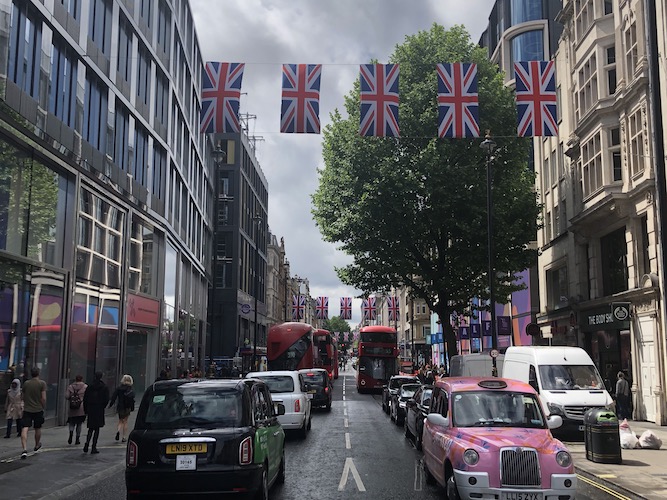
With the nation’s economy in turmoil following a government quasi budget that placed considerable faith in the capital’s economy to power a “new era” of growth, how are the West End and its most famous avenue, Oxford Street, shaping up to the challenges they face? How can the need to renew its attractions for visitors be most productively reconciled with the often different priorities of West End residents, of whom there are more than is widely appreciated, not all of them wealthy?
Those were were big, difficult and very interesting issues addressed at yesterday’s online event for On London supporters – the third of the six that will be held this year – by panelists Geoff Barraclough, who is Labour-run Westminster Council’s cabinet member for planning and economic development, Dee Corsi, the interim chief executive of business group New West End Company, and Andrew Murray, a resident of Soho and a campaigner for improvements to his neighbourhood and its environs.
There was common ground that Oxford Street is in urgent need of what Corsi called “TLC”, with shared enthusiasm for measures to make the environment more green, navigable and welcoming, and shared concerns about some of the newer retail presences, notably certain the clothing and souvenir emporia and the now notorious candy shops, which the council announced an initiative against last week.
‘The key problem with Oxford Street is it’s got the wrong kind of shops,” Barraclough said, citing the candy shops as “particularly wrong” and reporting that the council’s high profile efforts to enforce trading standards and “make it too embarrassing for landlords to have bad tenants” are having an effect, although “it’s like whack-a-mole”.
Murray mentioned the Marble Arch Mound, the well-meant but disastrous project of the previous, Conservative-run council administration aimed at drawing visitors back to the West End post-Covid, as “the classic symbol” of elaborate initiatives that cost a lot of money and haven’t worked, but also, at the eastern end of Oxford Street, “what’s called the Soho Photography Quarter” which has “one building and a few banners stuck up” and £3 million quid’s worth of paving that was a complete waste of money. We need to do things that are worth it”.
He was hopeful that the Labour administration elected in May, the first in Westminster’s history, will be an improvement, while recognising the vastness of the task it faces, saying he counted “at least 50 empty units” when walking along Oxford Street recently. Yet he also sensed “an opportunity coming up” for change of a good kind.
Of course, there were varying definitions of what kind of change is good. Corsi was positive about some aspects of “an evolution” in the types of brands being drawn to Oxford Street and the range of uses its buildings are being put to, substantially in response to changes in high streets and working habits that were already taking place, but Covid sharply accelerated.
She mentioned the branch of IKEA due to open in the Oxford Circus former home of Top Shop next year and, speaking of the West End more generally, noted new entertainment ventures such as the Outernet on Charing Cross Road, close to Tottenham Court Road station, and the repurposing of the ground floor spaces of clothing stores as restaurants. “People aren’t just coming to buy products, they’re coming for experiences,” she said. “With the pandemic we’ve seen that more people are actually craving that.” She sees the redevelopment as mixed-use schemes of the Debenhams and House of Fraser department store buildings as positive evidence of a desirable “additional diversity”.
Murray was less enthusiastic about the amount of development going on, as he has been in respect of the West End in general for some time. “I get that the West End is an economic powerhouse,” he said, and argued that its residents “have a crucial part to play in the attractions and the success of the centre of London”. However: “The construction boom and the concentration of property values and so on, that has a downside.” He applauded Barraclough for wanting the Marble Arch branch of Marks & Spencer to be retrofitted rather than demolished – a vivid case study of a much wider debate – and also appealed for more meaningful involvement of residents in development and other big decisions.
An emphasis on addressing residents’ concerns was an important feature of Labour’s historic election win, and Barraclough was sympathetic to quality of life issues Murray raised. “There are 45,000 people who live within 15 minutes walk of Trafalgar Square,” he said. “We’d like more people in the centre of town. But to have that you need an environment where they can get a good night’s sleep not walk out of their home to find someone pissing in their doorway.”
Murray also stressed the need to deal with the area’s stubborn and complex transport problems, of various kinds. “How much traffic is there, what sort of traffic is it? We don’t really know,” he said. “I think the council is looking to improve that sort of data. It has to take responsibility, because it has ramifications for everybody.” He also called for a clear definition of what “essential traffic” is and for a recognition that although “we all want more cycling”, a lot of residents are “pretty negative about cycling” because of the behaviour of some cyclists.
The discussion underlined that finding the right blend of priorities for a changing West End is an exacting but intriguing challenge. Corsi outlined a vision of “a repurposed West End, a mix of business, services and experiences to attract our workers and visitors”. Murray questioned the desirability of “a 24-hour city the way some people have envisaged it”, contending that this would mean “saying goodbye to ordinary mixed residential communities, and that’s not right.” Is it possible to nurture a West End that is more tranquil, more productive and more attractive all at the same time?
Academics at University College London have been exploring different scenarios for the West End’s future, but, said Barraclough, “No one’s yet shown me one that suggests we can have our cake and eat it”. Yet he also remarked: “We discovered through the pandemic that the various components of our central London economy – offices, culture, hospitality, retail and the residents – all reinforce each other. If any one of them is not firing on all cylinders then we have a problem.”
The search is on for the right blend, the best compromises and the shrewdest initiatives to harmonise all elements of the West End’s unique and shifting ecosystems. The discussion provided plenty of food for thought – and subjects for On London to write about in the coming months.
On London strives to provide more of the kind of journalism the capital city needs. Become a supporter for just £5 a month. You will even get things for your money. Details here.
Related
https://www.onlondon.co.uk/the-on-london-discussion-what-next-for-oxford-street-and-the-west-end/





